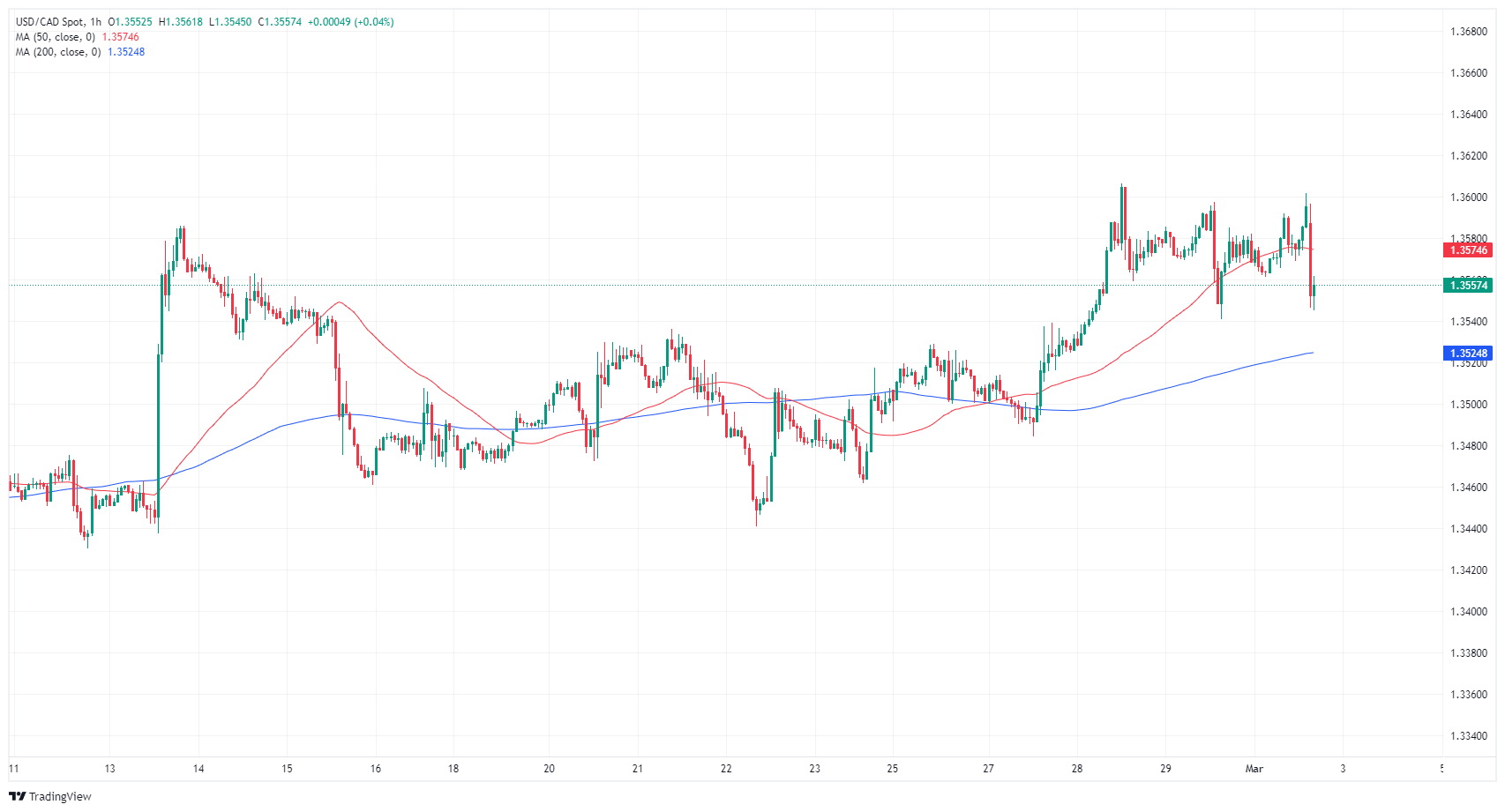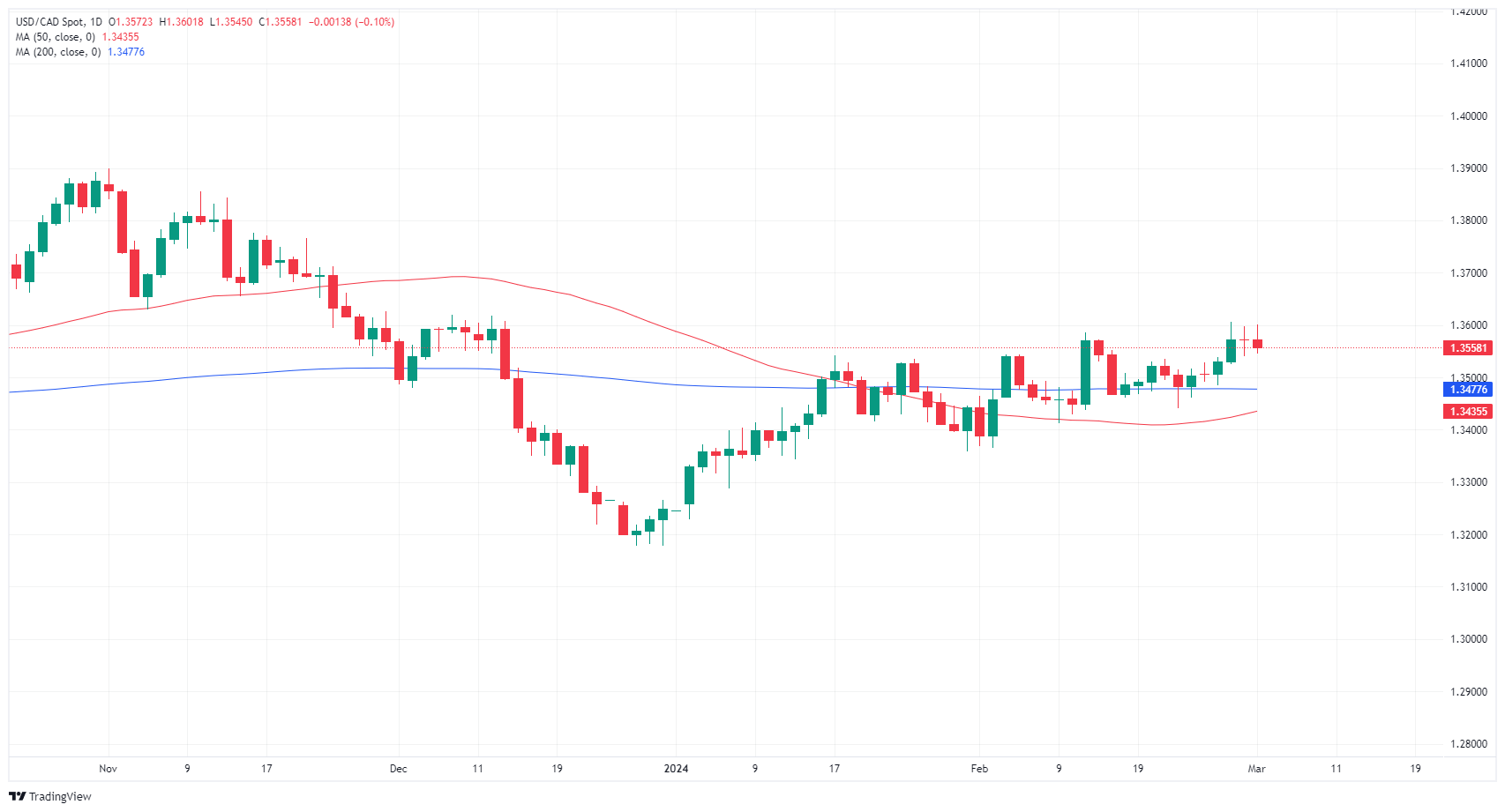- Analytics
- News and Tools
- Market News
- USD/CAD rebalances, backslides from 1.3600 after US ISM PMI misses forecasts
USD/CAD rebalances, backslides from 1.3600 after US ISM PMI misses forecasts
- USD/CAD flubs 1.3600 once again.
- Canada Manufacturing PMI recovers but still in contraction.
- US ISM Manufacturing PMI declined, flaunting forecasts.
USD/CAD fumbled the 1.3600 handle on Friday after a worse-than-expected US ISM Manufacturing Purchasing Managers Index (PMI) for February unexpectedly declined. The US Dollar (USD) was dragged broadly lower, sending the USD/CAD pair back into familiar technical territory near 1.3550.
Canada saw a decline in its S&P Global Manufacturing PMI on Friday, but market attention was focused on the day’s key US data print. Next week brings the latest rate call from the Bank of Canada (BoC) slated for next Wednesday, and next week will wrap up with another US Nonfarm Payrolls (NFP) on Friday alongside Canadian labor figures.
Daily digest market movers: USD/CAD falls back into range after ISM PMI miss
- Canada’s S&P Global Manufacturing PMI for February printed at 49.7 compared to the previous 48.3, an improvement but still in contraction territory below 50.0.
- The US ISM Manufacturing PMI for February fell to 47.8 versus the forecasted uptick to 49.5 from 49.1.
- ISM Manufacturing PMI: declines to 47.8 in February vs. 49.5 expected.
- The University of Michigan Consumer Sentiment survey index also eased to 76.9 in February, down from the forecast of a hold at the previous 79.6.
- ISM Manufacturing Prices Paid also ticked lower to 52.5, down from the 53.0 forecast and the previous month’s 52.9.
- Easing data is sparking investor risk appetite as inflation figures up odds of a Federal Reserve (Fed) rate cut.
- Fed’s Monetary Policy Report: Inflation expectations are broadly consistent with 2% goal
Canadian Dollar price today
The table below shows the percentage change of Canadian Dollar (CAD) against listed major currencies today. Canadian Dollar was the weakest against the Australian Dollar.
| USD | EUR | GBP | CAD | AUD | JPY | NZD | CHF | |
| USD | -0.23% | -0.16% | -0.14% | -0.47% | 0.07% | -0.31% | 0.01% | |
| EUR | 0.25% | 0.09% | 0.09% | -0.22% | 0.33% | -0.07% | 0.26% | |
| GBP | 0.16% | -0.08% | -0.01% | -0.31% | 0.24% | -0.14% | 0.17% | |
| CAD | 0.14% | -0.06% | 0.02% | -0.28% | 0.24% | -0.14% | 0.17% | |
| AUD | 0.47% | 0.23% | 0.30% | 0.28% | 0.55% | 0.16% | 0.48% | |
| JPY | -0.08% | -0.31% | -0.23% | -0.24% | -0.54% | -0.37% | -0.06% | |
| NZD | 0.31% | 0.07% | 0.12% | 0.15% | -0.16% | 0.38% | 0.28% | |
| CHF | -0.01% | -0.25% | -0.17% | -0.18% | -0.48% | 0.07% | -0.32% |
The heat map shows percentage changes of major currencies against each other. The base currency is picked from the left column, while the quote currency is picked from the top row. For example, if you pick the Euro from the left column and move along the horizontal line to the Japanese Yen, the percentage change displayed in the box will represent EUR (base)/JPY (quote).
Technical analysis: USD/CAD drifts back into the bottom end of near-term congestion below 1.3600
USD/CAD fell from an intraday high near 1.3600 to retest 1.3550 on Friday as the pair continues to grapple with near-term consolidation. A heavy supply zone at the 1.3600 handle is keeping bullish momentum pinned.
Higher highs are keeping daily candlesticks on the bullish side, but USD/CAD continues to wrestle with the 200-day Simple Moving Average (SMA) at 1.3477. A lack of topside momentum could drag the pair back into consolidation at the long-term moving average if buyers can’t break the 1.3600 level decisively.
USD/CAD hourly chart
USD/CAD daily chart
Canadian Dollar FAQs
What key factors drive the Canadian Dollar?
The key factors driving the Canadian Dollar (CAD) are the level of interest rates set by the Bank of Canada (BoC), the price of Oil, Canada’s largest export, the health of its economy, inflation and the Trade Balance, which is the difference between the value of Canada’s exports versus its imports. Other factors include market sentiment – whether investors are taking on more risky assets (risk-on) or seeking safe-havens (risk-off) – with risk-on being CAD-positive. As its largest trading partner, the health of the US economy is also a key factor influencing the Canadian Dollar.
How do the decisions of the Bank of Canada impact the Canadian Dollar?
The Bank of Canada (BoC) has a significant influence on the Canadian Dollar by setting the level of interest rates that banks can lend to one another. This influences the level of interest rates for everyone. The main goal of the BoC is to maintain inflation at 1-3% by adjusting interest rates up or down. Relatively higher interest rates tend to be positive for the CAD. The Bank of Canada can also use quantitative easing and tightening to influence credit conditions, with the former CAD-negative and the latter CAD-positive.
How does the price of Oil impact the Canadian Dollar?
The price of Oil is a key factor impacting the value of the Canadian Dollar. Petroleum is Canada’s biggest export, so Oil price tends to have an immediate impact on the CAD value. Generally, if Oil price rises CAD also goes up, as aggregate demand for the currency increases. The opposite is the case if the price of Oil falls. Higher Oil prices also tend to result in a greater likelihood of a positive Trade Balance, which is also supportive of the CAD.
How does inflation data impact the value of the Canadian Dollar?
While inflation had always traditionally been thought of as a negative factor for a currency since it lowers the value of money, the opposite has actually been the case in modern times with the relaxation of cross-border capital controls. Higher inflation tends to lead central banks to put up interest rates which attracts more capital inflows from global investors seeking a lucrative place to keep their money. This increases demand for the local currency, which in Canada’s case is the Canadian Dollar.
How does economic data influence the value of the Canadian Dollar?
Macroeconomic data releases gauge the health of the economy and can have an impact on the Canadian Dollar. Indicators such as GDP, Manufacturing and Services PMIs, employment, and consumer sentiment surveys can all influence the direction of the CAD. A strong economy is good for the Canadian Dollar. Not only does it attract more foreign investment but it may encourage the Bank of Canada to put up interest rates, leading to a stronger currency. If economic data is weak, however, the CAD is likely to fall.
© 2000-2025. All rights reserved.
This site is managed by Teletrade D.J. LLC 2351 LLC 2022 (Euro House, Richmond Hill Road, Kingstown, VC0100, St. Vincent and the Grenadines).
The information on this website is for informational purposes only and does not constitute any investment advice.
The company does not serve or provide services to customers who are residents of the US, Canada, Iran, The Democratic People's Republic of Korea, Yemen and FATF blacklisted countries.
Making transactions on financial markets with marginal financial instruments opens up wide possibilities and allows investors who are willing to take risks to earn high profits, carrying a potentially high risk of losses at the same time. Therefore you should responsibly approach the issue of choosing the appropriate investment strategy, taking the available resources into account, before starting trading.
Use of the information: full or partial use of materials from this website must always be referenced to TeleTrade as the source of information. Use of the materials on the Internet must be accompanied by a hyperlink to teletrade.org. Automatic import of materials and information from this website is prohibited.
Please contact our PR department if you have any questions or need assistance at pr@teletrade.global.















